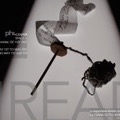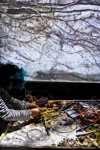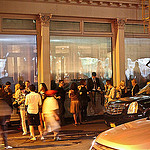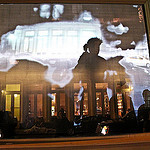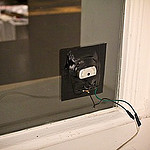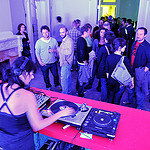|
sound installation
Ars Electronica Festival, Linz, 2016 [alchemists of our time exhibition]
Aquaphoneia is an alchemical installation centred around the poiesis of time and the transmutation of voice into matter. A large horn mid-space echoes the ghost of Edison’s machine. But unlike early recording, this odd assemblage transmutes voice into water and water into air. Vocal sounds falling into the depths of the horn are calcinated, and liquified: The aqueous voice then flows into three alchemical chambers where inner time is surrendered to the tempi of matter: unbound, yet lucid and sound. Aquaphoneia is an alchemical installation centred around the poiesis of time and transmutation of voice into matter. A large horn floating mid space echoes the ghosts of Edison, Bell, and Berliner’s machines. But unlike early recording, herding sound energy to etch pressure patterns in solid matter, this odd assemblage transmutes voice into water and water into air. Disembodied voices abandon their sources to cross the event horizon of the horn. Estranged, the schizo-phone falls into the narrow depths of the bell, squeezed into spatiotemporal infinity, calcinated, liquified and released: The aqueous voice then flows into three alchemical chambers where inner time is surrendered to the tempi of matter: unbound, yet lucid and sound. In one corner, voices bubbling inside a sphere of fire are brought to entropy and transmuted into a timeless concentration of spectral mist and phonetic vapour. An ouroboros chamber twists fermented vowels into distilled consonants to release a thin blade of prosody. This viscous alchemical matter lowers itself to the terra beneath where matter dances to its own affective tonality. Another module separates speech into vital elements a drop at a time: words into phonemes, into phono particles, and the invisible quanta of silence.
|
- NAVID NAVAB art direction, sound/installation concept and design, audiovisual composition, programming, behaviour design
- MICHAEL MONTANARO art direction, visual/installation concept, design and fabrication
- PETER VAN HAAFTEN electronics, sound, programming
- _
- consulting assistants: Nima Navab (embedded lighting design) Joseph Thibodeau (electronics)
- research collaboration: Topological Media Lab .
|
installation / a kinetic responsive sound sculpture
Phi Center, Biennale Internationale D’Art Numérique - 2014
CURRENTS New Media Festival, Santa Fe - 2015 Threads is an interactive installation that dwells with the mnemonic dimension of the written word and puts under the magnifying glass the acts of reading and writing in an intricate play of sensorial relations. Threads is an interactive installation that dwells with the mnemonic dimension of the written word and puts under the magnifying glass the acts of reading and writing in an intricate play of sensorial relations. Drop-spindles suspended in mid-air hold threads made out of hand-written paper, a transcription of a century-old correspondence. When touched, they produce sounds modulated on movement, that combine to create a mesmerizing environment. At a desk one is invited to reconsider the act of writing, by the use of an inkless pen and sonified paper. Threads reveals memory as a blueprint of sensation and suggests that its capturing is volatile and ephemeral.
|
Further, at the very end of the installation, on a desk one can find a letter size paper sheet and is invited to consider the act of writing, by the use of inkless pen on sonified paper. This computationally enriched paper responds to finest levels of nuance in the way it is manipulated. As one writes, audio-spotlights intimately project the micro-haptics of the pen scratching the paper into one’s ears.
Buried deep within the white page itself, voices start to appear. An ocean of audible murmurations couple with the participant’s writing gestures until slowly an intelligible speech starts to surface in dynamical gestural coordination, revealing the content of the letters suspended in the spindles by whispering a reading of them into one’s ears. Haptic noise is transmuted into an audible past, a Sonic Déjà Vu that morphs back into a pool of gentle noise as quickly as it had surfaced.
- NAVID NAVAB and OANA SUTEU artistic direction, installation concept, realization
- NAVID NAVAB composition, sound design, interaction design, programming, electronics
- OANA SUTEU sculpture and material design, visual design, original concept, visual anthropology
- _
- premiere: Phi Center, Biennale Internationale D’Art Numérique 2014
- residency: Matralab, Topological media Lab - 2014 .
|
Performance/Concert/Interactive Scenography
Premiere: March 2015 - Festival MNM Montréal/Nouvelles Musiques
Practices Of Everyday Life .com A synaesthetic performance organized around a chef, an enchanted kitchenette, and sonified ingredients. The cook wields foods, pans and spices, transmuted gesturally into sound and image in an innovative culinary choreography. A knife rasps against another, onions vocalize their unfolding, sizzling oil slides into a downpour of Bartok-pizzicati, while seductive aromas immerse the viewer in a multi-sensory augmentation of everyday practices. Cooking, the most ancient art of transmutation, has become a domestic practice over centuries. In this everyday practice, things perish, transform, and nourish other things. By augmenting the meats, wood, and metal, with sound and painterly light, we stage a performance made from the movements and gestures of cooking. The performance features a virtuosic chef/ dancer who wields foods, knives, pans and spices transmuted gesturally into real time sound instruments. Gestural sound compositions and responsive imagery unfold in realtime as the chef playfully prepares a meal with computationally enriched ingredients. Within the enchanted kitchenette, every food object and every gesture is turned into a dynamic event, full of relational indeterminacy. “Cooking” is the first part in a series of performances investigating the enchantment and musicalization of everyday practices, objects, and gestures. Future projects include an augmented surgical theatre, a concerto for a barber and enchanted hair, a percussion piece for a masseuse and cyborg flesh, as well as various real life interventions in public places. Making the imperceptible palpable, these performances utilize cutting edge gestural sound research, software, and acoustic sensing techniques to symbolically charge everyday actions and objects in ways that combine the composer’s design with the performer’s contingent nuance. By interactively varying the augmentation of an object’s natural acoustical response, we eliminate the a priori distinction between the synthetic/natural, instrument/score, intention/noise, or performer/performed. Performing or improvising music could then turn into an open engagement with matter, borrowing elements from “play”, day to day living, performance art, and the movement arts. |
- NAVID NAVAB artistic direction, concept, composition, real-time sound, interactive scenography, electronics
- JEROME DELAPIERRE real-time responsive video
- MICHAEL MONTANARO stage/movement direction
- TONY CHONG performance
- _
- Co-production: Navid Navab and Montreal/New Music Festival (MNM) - 2015
- Topological Media Lab: research collaboration - 2012-2013
- Matralab: residency - 2014 .
- Diane Martine-Graser, MUSIQUE CONTEMPORAINE Journal
- Katia Jean Paul, Art/culture BLOG
- The Link Newspaper
- Montreal Gazette
- CU Journal of Art History
|
Dance / Interactive Scenography
Premiere: dance: made in canada / fait au canada - Aug 2013
CINARS Biennale 2014
Steer exposes imaginary inner worlds through a fusion of biology, technology. The performance establishes a bridge to a dreamlike state and manifests thousand hidden worlds into a lucid reality. Steer exposes imaginary inner worlds through a fusion of biology, technology. The interplay of sound, visuals and light drives movement, interacting with and responding to nuanced movement. We direct our focus and energy between the internal and external worlds by modulating the speed and dynamics of our own motion. The performance establishes a bridge to a dreamlike state and manifests the hidden world of thought into reality. Dancer’s movements are processed through frameworks of technology: real time motion capture, camera tracking, on-body sensors and piezoelectric sensors. The inputs from these sensors are refined and interpreted in real-time by computer software, sound artist and visual artist to produce interactive lighting, sounds and visuals that are both initiated and continuously modulated by the dancer’s movements. |
- Concept/Direction: William Yong, Navid Navab, Jerome Delapierre
- Choreagraphy/Dance: William Yong
- Real-time Videa: Jerome Delapierre
- Composition, Sound and Interaction Design: Navid Navab
- Sensor System Design, Electronics and Interactive Scenography: Navid Navab
- Animation/Visual Design: Elysha Poirier
- Costume Design: Carl Penny
- Betty Oliphant Theatre, dance: made in canada / fait au canada, Toronto
|
Environment / Installation
March 2013
A set of time conditioning installations and techniques that create palpable alternatives to the everyday time that’s governed by calendars, universal clocks, and Internet services that never sleep. A new architecture of kinetic material and digital media in which time becomes an elastic medium of expression, learning, and invention - a new art of time for the 21c. Physical zones in which objects and fields of lighting, sound, and video change in concert with the inhabitants’ movement to create powerfully alternative senses of time, rhythm and pattern. A new architecture of kinetic material and digital media in which time becomes an elastic medium of expression, learning, and invention - a new art of time for the 21c. Einstein’s Dream is an environment in which visitors encounter performers in responsive fields of video, light, and spatialized sound, in a set of tableaus. Each tableau is inspired by a vignette from Alan Lightman’s novel, Einstein’s Dreams, set in Berne Switzerland, in 1904, the year that Albert Einstein received the Nobel prize. Or rather, a set of parallel 1904′s, each of which is a different kind of time. In one, time slows to a halt as you approach a particular place; in another there is no future; in third, time sticks and slips; in a fourth age reverses and what is rotten becomes fresh as time passes. In one version of this project, a large theatrical space (24m x 20m x 8m) will contain multiple tableaux, each accommodating 6-12 people in a pool of light and sound modulating in concert with activity. Visitors and performers can move from tableau to tableau. The performers’ actions, together with the textures and rhythms of lighting, sound and visitors’ expectations, create different kinds of time poetically related to the novel’s vignettes. As a performer walks from place to place she may drag a pool of conditioning light and sound. The pool mutates or merges into another pool with a different type of time. |
One hundred years after the two epochal advents in physics of relativity theory and quantum mechanics, we are still reverberating with the consequences. Einstein’s Dream is not a biography or a didactic allegory, but a poetic exploration of our consciousness in time.
There are many didactic works about the theory of relativity and quantum mechanics, including Einstein’s own popular essays, and canonical scientific / philosophical works by Hermann Weyl, Alfred N. Whitehead, Henri Bergson Duration and Simultaneity. In the arts, there have been some distinguished works that treat the theories and the theorists in an externalist way, as icons or as social phenomena. But what we propose is to work directly with the spectators’ felt experiences of time.
What Alan Lightman evoked in his novel was a poetic variation around the felt experience of time, not the “actual” physics of time, but alternatives of time, those hypothesized modes of living in time that could have been imagined, or that never were. By foregrounding how time works in these worlds, the vignettes foreground movement, which is the temporalization of the body. These movements are embedded in everyday life, made marvelous by poetic conceits of time. This fits perfectly with both Sha and Montanaro’s own artistic research into the charging of movement and gesture, of finding or evoking marvelous configurations of movement in the everyday.
Einstein’s Dream will create an experimental apparatus for inducing perceptibly different senses of temporal passage, chance and order, mortality and anisotropy — the arrow of time. Our goal is to use the techniques of theater and dance and responsive media to evoke sharply different kinds of temporal experience that the visitors will feel for themselves. Our experimental goal will be to discover ways to not just depict different kinds of temporal processes, but to condition a physical setting to yield in-person experiences of these different ways of being in time.
Pressure Sensing Floors
Infrared Tracking Cameras
16 chnl Speaker Array Arranged in a full sphere
Tactile Transducers
Contact Mics
Computers + Max/MSP/Jitter + VVVV
DMX System + Moving Lights
Ice, Fire, etc
- Concept/Direction/Realization: Michael Montanaro, Navid Navab, Jerome Delapierre
- Sound Design: Navid Navab
- Visual Design: Jerome Delapierre
- Light / DMX: Julian Stein
- Phenomenology of Time: Sha Xin Wei
- Physical Computing / Sensor System Design: Navid Navab
- Support: Topological Media Lab, Hexagram Concordia .
- Black Box, Hexagram, Montreal
|
Nuit Blanche, Goethe institute
Public Installation March 2013
Someone's behind those Venetian blinds. A finger slips over an edge and pulls them down. Two fingers, four. A pair of lips mouth your name. Then eyes appear from a darkened room, seeking to connect with those on the other side. Who is it? ... Someone's behind those Venetian blinds. A finger slips over an edge and pulls them down. Two fingers, four. A pair of lips mouth your name. Then eyes appear from a darkened room, seeking to connect with those on the other side. Who is it? And how does he or she know you, standing at the window, if she's only a ghost of a ghost. A seductive, beguiling interactive work veiling and unveiling perceptions. Who is the seer, and who or what the seen? Come to the Goethe Institute / La Nuit blanche, when *Alkemie animates the windows with responsive video-performers haunting video-persiennes. |
- Conception / Direction / Realization: Michael Montanaro, Jerome Delapierre, Navid Navab
|
installation / performance
SAT, Montreal, April 2011
Festival MNM, chapelle historique du bon pasteur - March 2015 Decay is an immediate response to the ongoing triple catastrophe that has hit Japan - the magnitude 9.0 earthquake, the tsunami, and the Fukushima nuclear emergency. Decay 崩壊 is an interactive sound installation/performance, first conceived spontaneously in March 2011 for the ”手向け Tamuke” Solidarity with Japan event. In view of ongoing triple catastrophe that hit Japan in summer 2011 - the magnitude 9.0 earthquake, the tsunami, and the Fukushima nuclear emergency - and also in view of many other natural and man-made disasters that humans face everyday, Decay encourages us to recognize the material world as a platform for enlightened practices: to press against, to locate resonance, to situate the body, and to engage the world as a site of buried sound. Decay 崩壊 invites audiences and performers to interact with natural and artificial found objects acoustically transmuted into sculptural electronic instruments, evoking post tsunami debris. Modulated through movement, objects sing of their past lives and continually recompose themselves into new meanings. Through varied augmentation of the object’s acoustical response, the natural and the synthetic collapse in immediate vibrational relation, whispering that perhaps we are produced by objects as much as we create them. In 2015, during the 4th anniversary of the Fukushima catastrophthe, the installation (Decay 2.0) was redesigned by Navab for a trio of musicians to interpret in short preludes throughout a evening long concert. |
- NAVID NAVAB Concept, Artistic Direction, Sound and Interaction Design, Instrument Design, Sculpture
- JEROME DELAPIERRE: Real-time Responsive Video (2011 version)
- SAT ,Montreal, QC, April 2011
-
Press
- http://www.sat.qc.ca/post.php?id=20&post_id=2129&lang=fr
- http://matralab.hexagram.ca/tamuke/
- Full press release: French ,English
|
MONSTROUS MUSINGS, UNCONSCIOUS UTTERANCES
Performance 2008-2011
Frankenstein’s Ghosts, is a collective creation-research project to build a hybrid critical discussion and performance work based on the substantive issues raised in Mary Shelley’s seminal novel, Frankenstein. Selections from documentation of the research creation and pre-production phase of Frankenstein's Ghosts. The project is simultaneously exploring themes inspired by Shelley's novel and finding monstrous forms of performance practice in the presence of responsive media.
|
- Concept/Direction: MICHAEL MONTANARO, ANNE-MARIE DONOVAN, NAVID NAVAB, JÉRÔME DELAPIERRE, Blue Rider ENsemble
- Michael Montanaro: Stage Director
- Anne-Marie Donovan: Assistant stage director and performer
- Blue Rider Ensemble: Musicians and Performers
- Navid Navab: Realtime Responsive Sound Design, Composition, Interaction Design, Spatialization, Performance
- Jerome Delapierre: Visual Design, Real-time Video
- Spike Lyne: Lighting
- Hexagram Black Box, Montreal, 2007-2010
- D. B. Clark Theatre, Montreal, 2011
-
Press
- http://www.frankensteinsghosts.com/
- http://www.interartsmatrix.com/projects/frankensteins-ghosts.html
|
Responsive Installation
Alkemie Atelier
Sep 2011, New York Responsive projections on three windows of the Alexander Wang store in New York for Fashion's Night Out 2011. Responsive projections on three windows of the Alexander Wang store in New York for Fashion's Night Out 2011. All windows of the store are blacked-out, creating an exclusive space inside the store. Pedestrians outside, tracked by a camera, can 'wipe' away the black-out on three of the windows to reveal live video footage of the inside of the store or alternately a mirror image of themselves. The projection can be seen from both the inside and the outside, giving the installation a dual purpose of allowing visitors inside to see outside and visitors outside to peak in at an exclusive talent-show event with VIP judges. Sound transducers on the windows project sonic events that are directly shaped by movements on the street. |
- Navid Navab: Sound Design, Responsive Sound Instruments (software/hardware), structure-born sound, sensing systems, installation
- Concept/Direction/Realization: Navid Navab, Jerome Delapierre, Michael Montanaro, Morgan Sutherland
- Production: Alkemie Atelier
- Alexander Wang Flagship Store FNO, New York
|
Performance, April 2010
L'envers, Montreal In today's capitalist service industry, our relation to the the food we eat is constantly replaced by virtualized objects of desire, and luxurious experiences constructed by efficient marketing strategies. To promote this kitsch state, the service industry seductively disconnects us from our food cycle, the eco-system, shit, flesh, and death and thus flattens existential and experiential diversity in relation to food and life. Journey Within is a performance piece focusing on natural rhythms of everyday life, and deconstructing the standardized modalities of eating as maintained by social ideology. The goal is to highlight, augment, and sonify various unintentional rhythms of the body and the environment to create an event that is at once objective and playfully personal. Journey Within destabilize the capitalist normalization of behaviour, and foregrounds our emotionally complex relation to food, shit, and the eco-life...
In today's capitalist service industry, our relation to the the food we eat is constantly replaced by virtualized objects of desire, and luxurious experiences constructed by efficient marketing strategies. To promote this kitsch state, the service industry seductively disconnects us from our food cycle, the eco-system, shit, flesh, and death and thus flattens existential and experiential diversity in relation to food and life. Journey Within is a performance piece focusing on natural rhythms of everyday life, and deconstructing the standardized modalities of eating as maintained by social ideology and the service industry. The goal is to highlight, augment, and sonify various unintentional rhythms of the body and the environment to create an event that is at once objective and playfully personal. Journey Within does not hold any specific ethical standpoint or a narrative about food but instead structures a performative and affective field to potentially reactivate repressed singularities, destabilize the capitalist normalization of behaviour, and bring into the foreground our emotionally complex relation to food, shit, and the eco-life. Morphing meat into metal: acoustic poetry
When faced with one, we tend to think of steak as another steak, or as a familiar object of desire. Throughout the performance (Journey Within), the elements of the meal are distanced from their usual appearance as food-objects. Every bite, every slice of meat, piece of lettuce, and every oral gesture is reinvented with maximum difference. This difference is not brought about as an appearance but as a dynamic event. Audio-visual augmentation of staged objects (events) liquefies the fixedness of forms and the virtual reality (casual efficiency) of consumerist perception and thus every food object, and every gesture becomes a dynamic event, full of relational indeterminacy.In the provided track it is possible to hear the alchemical transformation of meat while being cut. In the sample audio, meat turns into wood, metal, string, etc and looses it's familiarity. (note: refer to track #3) The transformations are continuously varied and analogue, sometimes piercing to the ear and at other times lyrical. While the sonic materiality of the meat is continuously differentiated, and autonomized, the cross-modal totality of the object (meat) takes a different path. Smell of raa meat and blood mixed with burning oil add a cruel texture to its lyrical transformations and modulate the sound-smell horizon which itself clashes with the cruelty of the visual scenery. |
We need to free ourselves from the comfortable table of capitalism that serves us familiar foods within far too familiar situations and expects us to stop living eventful lives and instead perform our duty as uniformed consumers. Journey Within activates wide-open subjectivities that are not afraid to face the indeterminate liveliness of everyday life, of desire, suffering, and death.
Aesthetic decentralization of everyday points of view or components of expression will deconstruct the discursive code in use and will disconnect the material functions of power from the materiality of basic sensations. During performances, specially after intensely sensational and "cruel" moments (cruel in an Artaudian sense.) , after the decentralization of power has taken place, re-composition of forces and motifs can take place and new existential territories can be invented.
The audience is given a chance, a relational field, to extract new and unbounded forms, meanings, oralities, moralities and percepts from the otherwise familiar dinning situation. The emergent moralities and modalities are more likely to be in closer contact with ecological and mental complexities of oral behaviour than if they were left centralized and directed by the subjugated tonality of standardized mentality. Through the "autopoiesis of aesthetic affects" new ways of living emerge from the performance and spread through the world. During the course of the staged meal something is cut open, eaten, digested, decomposed, and new ways of living and lines of meaning are drawn out from within and into the society.
- Concept/artistic direction: Navid Navab
- Realtime-sound: Navid Navab | Julian Stein
- Realtime-video: Jerome Delepierre
|
Responsive environment {installation}
Electric Eclectics Festival, Ontario, Aug 2009
Timisoara Student Festival at D’arc terrace, Romania, May 2010 Festival du Nouveau Cinema, Montreal, Oct 2010 The Constellation is a responsive, multi-media environment, expressed through sound, light and movement in the form of architecture. It is an interactive installation that engages visitors with their surroundings in order to create a unique spatial experience sensitive to the site. Constellation is responsive to natural and man-made physical pressures in the built environment...
Constellation 2.0 was a temporary interactive audio/visual installation for the Electric Eclectics festival in Meaford Ontario, July 2009. |
Activated with a series of embedded sensors across the continuous surface, the sonic environment responds to the presence of visitors, wind, rain and surroundings of the site. Constellation 2.2′s architecture hints at the importance of built-environments adaptability to media and the next generation of smart spaces. Constellation 2.2 will register and absorb it’s surrounding environment and slowly transform it into active fields of movement, sound, and light. The hard architecture of the adjacent buildings will slowly melt into the skin of the installation: Out of the front facades of the building an organic creature will grow into the soft skin, evolve, interact and transform it’s environment. Upon interacting with the installation, the audio-visual fields of movement are interrupted, leading to a variety of changes in the behaviour of the organism. Constellation 2.2 is thus able to shift from one form to another over the course of the installation. The Constellation at the FNC creates an ephemeral experience in downtown Montreal.
- Concept/Direction/Realization: Mani Mani, Navid Navab, Jerome Delapierre
- Mani Mani: Architecture
- Navid Navab: realtime responsive sound, interaction and sensor system design
- Jerome DelaPierre: realtime responsive video
- Electric Eclectics Festival, Meaford, Ontario, Ontario, Aug 2009
- Timisoara Student Festival at D’arc terrace, Romania, May 2010
- Festival du Nouveau Cinema, Montreal, Oct 2010
- The Link newspaper
- Lien Multimedia
- Article by Stephanie Brown:
-

.
|
Public Installation / Responsive Architecture
Guy Metro Entrance, Montreal, QC
March 2009 BUBBLEpop is an interactive audio-visual installation intended for a public foot-traffic. The floor of a public space is covered with augmented sheets of bubble-wrap that people are invited to walk over, popping bubbles and transforming the surrounding audio-visual environment. Certain areas of the bubble-wrap sheets are equipped with piezoelectric microphones that sense the participant's interactions and transform them into synthesized sound and video. Through the joyous act of popping air bubbles with varying speed and intensities, the passersby gesturally shape the multichannel audio and video projection.
BUBBLEpop is an interactive audio-visual installation intended for a public foot-traffic. The floor of a public space is covered with augmented sheets of bubble-wrap that people are invited to walk over, popping bubbles and transforming the surrounding audio-visual environment. Certain areas of the bubble-wrap sheets are equipped with piezoelectric microphones that sense the participant's interactions and transform them into synthesized sound and video. Through the joyous act of popping air bubbles with varying speed and intensities, the passersby gesturally shape the multichannel audio and video projection. As participants pop bubbles over the 'surprise zones' that have contact-microphones embedded in them, the collected sounds get processed and spatialized by a specific multi-channel sound architecture. The effect is that, while most bubbles and their popping sound stay natural and unprocessed, certain zones upon interaction suddenly offer supernatural qualities that await to be discovered and explored by the more curious audiences. The video projection consists of rich dynamic textures, often resembling viscous bubbles, that respond to the popping of the bubble- wrap. At times the video is calm until a bubble is popped – the video reacts with a percussive event that mirrors the popping sound. BUBBLEpop uses an innocently simple yet richly embodied mode of interaction to allow participants of all ages, interests, and backgrounds to step out of their everyday routines to reflect on the surrounding architecture, the acoustics of the built environment, the relationship movement, wonders of haptic sound, and moving-image, and their own submissive relationship with gravity. BUBBLEpop awakens the playful desires within all of us. The exact BUBBLEpop setup is highly dependent on the installation site. The installation is best suited for indoor public spaces and specially high-traffic architectural thresholds where the popping noises do not interfere with other sound sensitive installations. |
- EV building, Guy Metro Entrance, Concordia University, Montreal, QC
- Navid Navab: Concept, Design, Realization
|
Responsive Light Installation
Canadian Center for Architecture
2009 Immersive LED lighting and projection installation for the Canadian Center for Architecture's 20 Years: 20 Hours event. Immersive LED lighting and projection installation for the Canadian Center for Architecture's 20 Years: 20 Hours event. High-power RGB LED luminaires aimed at the windows of the adjunct Shaughnessy House fully illuminate the interior. The room is awash with color while the LEDs animate to depict a low-resolution sunrise and sunset across all four rooms. The speed of the sunset and the color changes are modulated by a live feed from the DJ and other environmental sounds within the building. Inside the gallery, a time-lapse projection of the sky on the ceiling and a subtle black and white responsive projection create an immersive experience for spectators of a musical performance by BRAIDS. |
- Canadian Center for Architecture
- Concept/Direction/Realization: Navid Navab and Morgan Sutherland
- co-production: Topological Media Lab and Canadian Centre for Architecture
|
Performance / Improvisation
Interactive Scenography
2008 Interstitial is an interactive audio-visual performance/installation by Navid Navab and Jerome Delapierre. It is an improvisational performance piece for an interactive screen, a dancing body, and live audio/video processing. By augmenting a stretchable projection surface with sensors and responsive technology, we map movement and vibration to audio-visual textures. Relative to physical and spatial qualities of the screen, meaningful and playable mappings were created from gestures and vibrations to sound and video. During performances we continuously transform the screen's responsive qualities by performing it's mapping-space. Upon touching the screen and interacting with it, players discover that they can charge their gestures with emotion and meaning, and use their interactions for improvised play. |
- Summer 2008: TJ Contemporary Dance Theater, Montreal, QC
- March 2010: Synchresis, Eastern Bloc, Montreal, QC
- Concept / Artistic Direction / Realization : Navid Navab | Jerome Delpierre
- Realtime Responsive Sound: Navid Navab
- Realtime Responsive Video: Jerome Delpierre
- Performance(movement): Bruno Gagnon
- Residency : Topological Media Lab
|
Responsive Environment / Kinetic Sculpture
Sep-Oct 2008
8th Manifestation Internationale of Champ Libre, Montreal Shanghai eARTS 2008 Festival (HORIZON), China
Air-filled plastic sculptures laced with sensors and LED illuminators breath, filter and re-project data harvested from outside as patterns light and sound.
"Pneus, exists in a world of second nature, a world made by human hands but governed also by electricity, and gravity. ...[ More ] Pneus aims to construct an immersive experiential condition in which the participant’s impression is that of being within a forest. Air-filled plastic sculptures laced with sensors and LED illuminators breath, filter and re-project data harvested from outside as patterns light and sound.
"Pneus, exists in a world of second nature, a world made by human hands but governed also by electricity, and gravity. Its roots extend into the subterranean world of infrastructure, and its canopy drinks sunlight. By suspending Pneus off the ground, overhead, we up-end the earth to expose its roots, and let those who walk underneath the installation experience the rhythms Pneus extracts from the street and the building as dappled light and shadow, much like dappled shade on the forest floor. Like an air-plant, Pneus adheres lightly to its host, drawing rhythms from the heart of the building and releasing them into the exterior as a kind of music." Manifestation Goals:
Pneus will act as a projective filter for temporality as well as space. A polyrhythm of temporal scales from spans of one month to milliseconds will be exploited.Pneus will engage the temporality of responsive gestures to create a complex layering of delayed and accelerated behavior, climate, movement, temperature and proximity. Pneus will be a memory bank of responses, actively replaying the one day’s event in an evening, whether there are witnesses or not. It uncannily embeds the activity of a forest of life without being obvious. At a material level a slower temporality will initiate change and transformation in the piece. A varying degree of biodegradation and ultraviolet deterioration will be exploited to suggest a material cycle of decay and rejuvenation. While parts of the installation will degrade, it will be an explicit intention to acquire, accumulate and expand the biological filter of the piece. We consider Pneus to be a kind of analogue computing in which cells and the interactions between (pneumatics, elctronics, structural systems etc) allow for the possibility of developing some analogue computation from this network. Our investigation is also considering the use of bioluminescent fluids in the bottoms of the tubes, actuated at night through a very mild electrical stimulus. |
- Sep 2008, 8th Manifestation Internationale of Champ Libre, MONOPOLI Architecture Gallery, Montreal
- Shanghai eARTS 2008 Festival (HORIZON), China
- Direction /Architecture: Patrick H. Harrop, Peter Hasdell, Xin Wei Sha
- Sound Installation Direction and Concept, Responsive-Sound, Interaction Design, Physical Computing: Navid Navab
- Extra Support and Media Programming: Topological Media Lab
- Costume-made Sensor System: ESKI montreal
|
Responsive Architecture, Enactive Interfaces
Nov 2007
"One’s behavior changes as one learns to cope with new conditions and situations. And, as one’s actions change, so too does one’s sense of the world. If these changes are dramatic enough then a different perceived world will be enacted."(Varela) Enactive Walkway is a responsive installation that examines the intersection of cognition, embodiment and human experience. The structure runs the length of a hallway and is embedded with illuminated transparent...
Enactive Walkway:
|
Sonic: real-time projection of the sound.
Above: a screen optically interacts with people’s movement.
The surface of the walkway is comprised of a series of tile-boxes, each containing a different substance. When the tile-box is stepped on, the surface moves, disturbing the contents of the tile-box. Lights from below interact with these disturbances. The sound of the disturbance of the contents of the tile-boxes is audible in real-time.
Each tile-box is transparent and contains a different substance which is chosen based on its sonic and optical qualities. (water, broken glass, bamboos, etc…)
The tile-boxes move on three axes. They are illuminated from below and respond to movement with slow and subtle changes.
Various sensors in each tile-box capture people’s interaction with the boxes. (Sonic and dynamic data from the boxes are mapped to intensity of L.E.D. lights.)
The ceiling creates a tension between the optical and physical movement.
A lenticular screen shows motion as the angle of viewing changes.
Separate lenses are phased, to seem as a a single sheet, containing several dissolving images.
The images printed on the lens reflect an abstract representation of the boxes’ content.
- Concept | Design | Construction: Navid Navab, Maziar Javidani, Angela Gabereau
- Navid Navab: real-time Responsive Sound/Light Design, Interaction Design, Physical Computing, Programming












